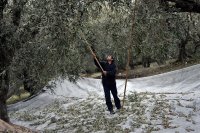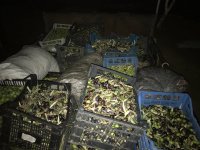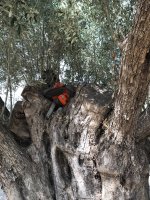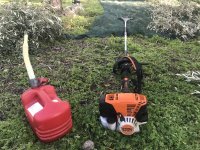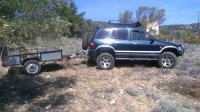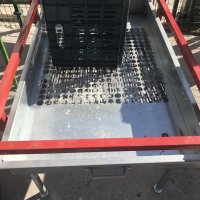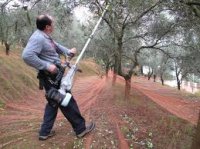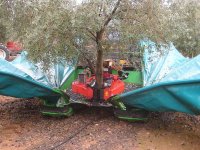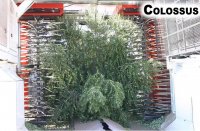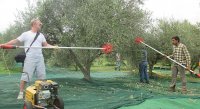- Local time
- 9:12 PM
- User ID
- 5546
- Joined
- Mar 8, 2018
- Messages
- 6,000
- Reaction score
- 45,140
- Location
- Evia, Greece
Some guys on here had asked me to do a write-up on Olive trees, to include, harvesting, care, pruning, and oil production. I wasn’t sure which parts to include or provide the most information on, so I guess I’ll just go ahead and include all of it from the start until today. I apologize for the length in advance. For those of you that like a read, it should be right up your alley. I'll do the thread in multiple posts and will probably make it pretty picture intensive...you guys like pics, right? I'll try to include as many of my own pics as possible, but I want to say thanks to Google in advance in case I need to "borrow" a pic or two. Feel free to ask any questions you guys have. I really don't mind tailoring the info to what folks are curious about. This write-up will be saw, OPE and firewood related also...
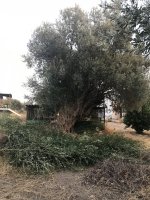
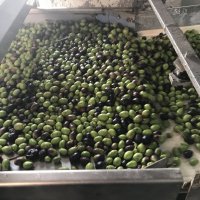
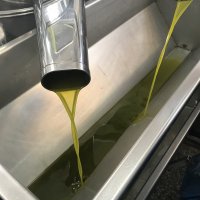
“Let food be thy medicine and medicine be thy food” – Hippocrates
Where to start? Well, the beginning of my olive tree and olive oil experiences would be the easiest. After being stationed in Greece with the US Air Force, I started buying olive oil at a consumer level at the supermarkets in Athens. I had no idea about the differences in oil, other than what the labels told me. They were labeled in every shape and fashion, including Spartan helmets for oils that came from Sparta and other regional icons adorning the bottles. Extra Virgin, Virgin, Hot Pressed, Cold Pressed…. what did all these catchy marketing words mean that were on the labels? Just like walking into an OPE dealer, one could easily get lost with all the options available if they had no prior experience. At this point, I had no idea of the olive secrets Greece would reveal to me. I had no idea there was a whole other world of olive oil production, oil trade and oil usage and consumption just waiting to be discovered. I had no idea about different olive types and their impact on the oil’s quality, color and taste. I had no idea how quality varied year to year and how the sea, mountains and soil attributed to the acidity, aroma and bitterness of taste. I had no idea that trees produced in cycles, and I had no idea what it took to squeeze out this green liquid gold.
I had always been curious about olives and oil production, so I spent a lot of time just checking the fields as I drove by. I didn’t know anyone that had trees, and the people I encountered had olive groves in villages far away from where I lived. Many times, I found myself trying to envision how the olives were transformed into oil. Coming from a farming background, this really piqued my curiosity. I saw some of the old round stone wheels that were used in pre-electricity days for pressing olives into oil, but modern techniques were still a mystery to me.
Fast forward about 5-years and we find ourselves in an abandoned property that belonged to my wife’s family on the island of Evia. We had moved there to protect the property from vandals and thieves. The property had around 40 mature olive trees of various ages. Some were huge and severely overgrown, and others were smaller and had varying leaf shapes and bark differences. So much going on there and I had no idea where I was going to learn everything I desired to know about olives and the trees that grow them.
I found myself one day standing in front of a giant Koroneiki (Crown) olive tree, MS170 in hand and ready to do some damage. Yet, I had no fricking clue where to start. Should I cut that limb? Or, that one? What if I screw it up? Will the tree suffer? How long will it take to grow back? Will the tree still make olives if I go to whacking it apart? I decided to cut a couple of limbs that were just hanging over a building and leave the rest until I got some advice.
A local farmer and landowner came one day and gave me some tips and advice. He told me where to cut and how to identify which limbs were useful for production and which ones were degrading the tree’s ability to produce to full potential. That was my first experience in care and maintenance of the olive tree.
Fast forward another 5-years and here we are in 2020. The year’s harvest is in the books and we are enjoying the bounty of a wonderful harvest year. We averaged a 5:1 ratio of olives to oil, an average acidity of 0.5% and around 100 gallons of Extra Virgin green gold in our storage shed. What does acidity mean and what determines the olive to oil ratio? We’ll get to that, but first some facts and stats of Greek olive oil production and distribution.
Facts of Greek Olive Oil Production
Greece produces nearly 17% of the world’s overall olive oil production. It’s third only to Spain and Italy and is the leader in production of Extra Virgin oil--80% of all Greek oil is Extra Virgin. Greece has over 100 million fruiting olive trees that produce 350,000 metric tons of oil, which generates 1.4 billion Euros in annual revenue.
Greeks consume an average of 16 kilos (32 pounds) of oil per year, per person. Even with highest consumption rate for olive oil in the world, Greece still leads all other countries for exportation of Extra Virgin Olive Oil.
At this point you may be saying, “I don’t see Greek olive oil in the supermarket”. But you do. Major companies like Bertolli buy Greek olive oil and blend with their own and resell it under their label. Most olive produced in Greece is exported in bulk and bottled at other locations. Why? Well, there are several reasons. Probably the most prevalent is that Greek farms are very small and scattered, so getting the oil from the farms to the olive presses is primarily done with traditional techniques. Most of the harvesting in my area is accomplished manually by the farm owners. Typically, small farmers are not involved with exportation or sales. They give a portion of their harvest to the olive press in exchange for producing their oil. The olive press will collect their oil and sell to larger companies that will then market to the oil to foreign buyers. Additionally, Greece’s geography is attributed to making a very high-quality oil yet is difficult for harvesting due to mountainous growing areas. In fact, Greece is 80% mountainous. Many of the areas that grow olives are slopes where it is difficult for machinery to operate, so care, harvesting and transport is primarily accomplished by manual labor.
Olive groves in Crete
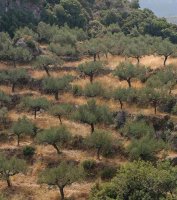
Olive groves at the mountainous foothills of Evia Island
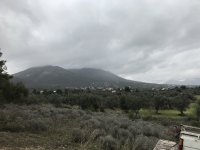



“Let food be thy medicine and medicine be thy food” – Hippocrates
Where to start? Well, the beginning of my olive tree and olive oil experiences would be the easiest. After being stationed in Greece with the US Air Force, I started buying olive oil at a consumer level at the supermarkets in Athens. I had no idea about the differences in oil, other than what the labels told me. They were labeled in every shape and fashion, including Spartan helmets for oils that came from Sparta and other regional icons adorning the bottles. Extra Virgin, Virgin, Hot Pressed, Cold Pressed…. what did all these catchy marketing words mean that were on the labels? Just like walking into an OPE dealer, one could easily get lost with all the options available if they had no prior experience. At this point, I had no idea of the olive secrets Greece would reveal to me. I had no idea there was a whole other world of olive oil production, oil trade and oil usage and consumption just waiting to be discovered. I had no idea about different olive types and their impact on the oil’s quality, color and taste. I had no idea how quality varied year to year and how the sea, mountains and soil attributed to the acidity, aroma and bitterness of taste. I had no idea that trees produced in cycles, and I had no idea what it took to squeeze out this green liquid gold.
I had always been curious about olives and oil production, so I spent a lot of time just checking the fields as I drove by. I didn’t know anyone that had trees, and the people I encountered had olive groves in villages far away from where I lived. Many times, I found myself trying to envision how the olives were transformed into oil. Coming from a farming background, this really piqued my curiosity. I saw some of the old round stone wheels that were used in pre-electricity days for pressing olives into oil, but modern techniques were still a mystery to me.
Fast forward about 5-years and we find ourselves in an abandoned property that belonged to my wife’s family on the island of Evia. We had moved there to protect the property from vandals and thieves. The property had around 40 mature olive trees of various ages. Some were huge and severely overgrown, and others were smaller and had varying leaf shapes and bark differences. So much going on there and I had no idea where I was going to learn everything I desired to know about olives and the trees that grow them.
I found myself one day standing in front of a giant Koroneiki (Crown) olive tree, MS170 in hand and ready to do some damage. Yet, I had no fricking clue where to start. Should I cut that limb? Or, that one? What if I screw it up? Will the tree suffer? How long will it take to grow back? Will the tree still make olives if I go to whacking it apart? I decided to cut a couple of limbs that were just hanging over a building and leave the rest until I got some advice.
A local farmer and landowner came one day and gave me some tips and advice. He told me where to cut and how to identify which limbs were useful for production and which ones were degrading the tree’s ability to produce to full potential. That was my first experience in care and maintenance of the olive tree.
Fast forward another 5-years and here we are in 2020. The year’s harvest is in the books and we are enjoying the bounty of a wonderful harvest year. We averaged a 5:1 ratio of olives to oil, an average acidity of 0.5% and around 100 gallons of Extra Virgin green gold in our storage shed. What does acidity mean and what determines the olive to oil ratio? We’ll get to that, but first some facts and stats of Greek olive oil production and distribution.
Facts of Greek Olive Oil Production
Greece produces nearly 17% of the world’s overall olive oil production. It’s third only to Spain and Italy and is the leader in production of Extra Virgin oil--80% of all Greek oil is Extra Virgin. Greece has over 100 million fruiting olive trees that produce 350,000 metric tons of oil, which generates 1.4 billion Euros in annual revenue.
Greeks consume an average of 16 kilos (32 pounds) of oil per year, per person. Even with highest consumption rate for olive oil in the world, Greece still leads all other countries for exportation of Extra Virgin Olive Oil.
At this point you may be saying, “I don’t see Greek olive oil in the supermarket”. But you do. Major companies like Bertolli buy Greek olive oil and blend with their own and resell it under their label. Most olive produced in Greece is exported in bulk and bottled at other locations. Why? Well, there are several reasons. Probably the most prevalent is that Greek farms are very small and scattered, so getting the oil from the farms to the olive presses is primarily done with traditional techniques. Most of the harvesting in my area is accomplished manually by the farm owners. Typically, small farmers are not involved with exportation or sales. They give a portion of their harvest to the olive press in exchange for producing their oil. The olive press will collect their oil and sell to larger companies that will then market to the oil to foreign buyers. Additionally, Greece’s geography is attributed to making a very high-quality oil yet is difficult for harvesting due to mountainous growing areas. In fact, Greece is 80% mountainous. Many of the areas that grow olives are slopes where it is difficult for machinery to operate, so care, harvesting and transport is primarily accomplished by manual labor.
Olive groves in Crete

Olive groves at the mountainous foothills of Evia Island







